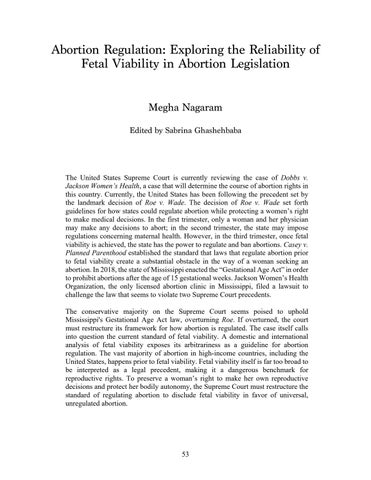Abortion Regulation: Exploring the Reliability of Fetal Viability in Abortion Legislation Megha Nagaram Edited by Sabrina Ghashehbaba
The United States Supreme Court is currently reviewing the case of Dobbs v. Jackson Women’s Health, a case that will determine the course of abortion rights in this country. Currently, the United States has been following the precedent set by the landmark decision of Roe v. Wade. The decision of Roe v. Wade set forth guidelines for how states could regulate abortion while protecting a women’s right to make medical decisions. In the first trimester, only a woman and her physician may make any decisions to abort; in the second trimester, the state may impose regulations concerning maternal health. However, in the third trimester, once fetal viability is achieved, the state has the power to regulate and ban abortions. Casey v. Planned Parenthood established the standard that laws that regulate abortion prior to fetal viability create a substantial obstacle in the way of a woman seeking an abortion. In 2018, the state of Mississippi enacted the “Gestational Age Act” in order to prohibit abortions after the age of 15 gestational weeks. Jackson Women’s Health Organization, the only licensed abortion clinic in Mississippi, filed a lawsuit to challenge the law that seems to violate two Supreme Court precedents. The conservative majority on the Supreme Court seems poised to uphold Mississippi's Gestational Age Act law, overturning Roe. If overturned, the court must restructure its framework for how abortion is regulated. The case itself calls into question the current standard of fetal viability. A domestic and international analysis of fetal viability exposes its arbitrariness as a guideline for abortion regulation. The vast majority of abortion in high-income countries, including the United States, happens prior to fetal viability. Fetal viability itself is far too broad to be interpreted as a legal precedent, making it a dangerous benchmark for reproductive rights. To preserve a woman’s right to make her own reproductive decisions and protect her bodily autonomy, the Supreme Court must restructure the standard of regulating abortion to disclude fetal viability in favor of universal, unregulated abortion.
53

